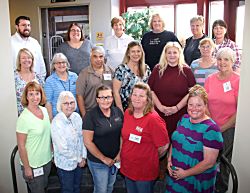USTA conducts clerk and charting school
May 10, 2018,from the USTA Communications Department
Columbus, OH — Seventeen people, including 13 who were attending for the first time and four who were taking it as a refresher course, participated in the USTA’s clerk and charting school held in the home office in Westerville, Ohio, from Tuesday (May 8) through Thursday (May 10). The school was conducted by USTA Racetrack Operations and Licensing Manager Michele Kopiec.
The 17 students who attended came from eight different states — Delaware, Florida, Indiana, Kentucky, Michigan, New York, Ohio and Pennsylvania.

USTA/Mark Hall photo
Seventeen people participated in the USTA’s clerk and charting school.
“This was a great opportunity for the USTA to host a class that involved so many people from various states,” said Kopiec. “We were pleased to welcome new individuals as well as some who had done this before. The USTA Race Track Support team works diligently to make sure that quality and consistent chart information is being entered into the database. By continuing our commitment to provide that type of information, our horsemen as well as horseplayers will benefit from this USTA service.”
The curriculum was a comprehensive course that covered all of the procedures and requirements for using eTrack, which is the system utilized in race offices at both pari-mutuel and county fair tracks to create race programs and submit entries and results to the USTA.
“It’s not required and I really don’t do it anymore, but I was a licensed program director and charter for 20-some years at Brandywine Raceway and Dover Downs,” said current Delaware Standardbred Breeders Fund Executive Director Judy Davis-Wilson. “I still keep my hand in it because, from a sire stakes perspective, I have to be out there at the track and utilize e-Track a lot.
“My take from the days of RTS since they started it in 1984 is that they’ve made it much easier because one person can do what three used to do,” added Davis-Wilson.
In addition to the classroom work conducted at USTA headquarters, participants also attended the races at Scioto Downs on Tuesday afternoon to shadow the track’s charter. Then the following day, the Scioto race results and charts were used by the students to enter into the eTrack system.
“The experience was really good at Scioto (Downs),” said Dominick Rosato, a retired deputy sheriff who is an owner and breeder in New York. “It gave you a really big eye opening of what somebody goes through to chart for under two minutes, all the stuff that has to be taken into account.”
On Wednesday, USTA Registrar T.C. Lane addressed the group during lunch to provide details on the USTA’s new microchip initiative and explained how that information would now be incorporated into eTrack reports.
On Thursday morning, each of the 13 new participants took a written exam as the first step toward becoming a licensed charter and/or clerk. The next step for those who pass the exam is to go out into the field and gain practical, on-the-job training from a licensed charter and/or clerk. The final step in the licensing process is to obtain a positive reference from that licensee.
